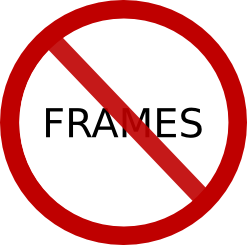 It is quite tempting to resort to graphical and media-type of navigation for appearance and interactivity. But in search engine optimization ( SEO ), these can still be no-no options. Search engine spiders are generally designed to crawl text-based pages. Whenever spiders don't have the capacity yet to understand website content other than text, the following navigation techniques must be avoided in SEO Web design :
It is quite tempting to resort to graphical and media-type of navigation for appearance and interactivity. But in search engine optimization ( SEO ), these can still be no-no options. Search engine spiders are generally designed to crawl text-based pages. Whenever spiders don't have the capacity yet to understand website content other than text, the following navigation techniques must be avoided in SEO Web design :1. Frames
Search engine still have some difficulty reading pages within frames. This is because search engine will index them as broken links. As such, only the navigation part will most likely be read while the linked page will be read as blank.
2. Flash
Search engine cannot possibly analyze image and video contents of a flash-based website. Creating a text-based html description of the page might give some information about flash-content. But this will only double your effort making two pages but spiders will only index one of them.
3. Graphical Navigation Icons or Buttons
Search engine cannot extract content from an image made up of pixels. Making use of Alt tags will only have lesser SEO impact compared to using text-based navigation system. Moreover, your site will also miss the dual SEO benefits of anchor text.
4. Javascript
Search engine spiders cannot effectively follow links within or generated by javascript. Although an alternate text navigation could help a bit to crawl other pages of your site, it is already steps behind when you just simply used text-based navigation.
5. Dynamic URL's and Session ID's
Dynamic URL's and session ID's are unique identifiers to track visitor's navigation path. However, each visit can generate a different URL or ID and then terminate upon closing browser. Seacrh engine will not or cannot index almost entirely same content but of different URL's.
Not SEO-Friendly Website Navigation Techniques
 Reviewed by Unknown
on
12:39 PM
Rating:
Reviewed by Unknown
on
12:39 PM
Rating:
 Reviewed by Unknown
on
12:39 PM
Rating:
Reviewed by Unknown
on
12:39 PM
Rating:




2 comments:
hi
great info........
thanks for sharing very useful information about Not SEO-Friendly Web site Design Navigation Techniques.
Web development
The ultimate goal of any website is to attract traffic to the site and earn maximum profits by bringing the website in the top search pages.
Website Development company in Bangalore
Post a Comment